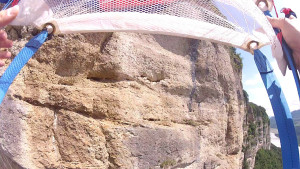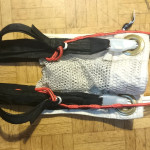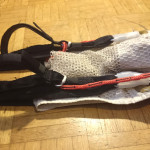On one of my recent slider down jumps I had a 180 and encountered an issue with the slider that I never really thought about or realized before – grabbing the slider together with a backriser.
Here’s just a brief summary of the pros and cons of slider down and slider off configurations, scroll down to the video for the jump and my analysis.
Slider down means leaving the slider on and securing it to one of the risers, while slider off means that the slider is taken off the rig entirely.
Slider off configuration reduces the anhedral angle of the canopy a bit and makes it glide and flare slightly better. Also packing will be a bit cleaner and faster since its one component less to take care of. The downside is that reconfiguration from slider off to slider up and vice versa takes longer, requires tools, and introduces the chance of misrigging.
Slider down makes it a lot quicker to switch from slider up to slider down and vice versa without any tools required and less opportunities for misrigging. On the other hand, packing takes a minute or two longer because you have to take care of the slider and stow it properly.
There are a few things that I fucked up there, first, I grabbed the backriser too low, limiting the amount of steering input I could apply, and second, I got some portion of the slider in my hand, giving me an unusual feeling of steering pressure at some point because I was also pulling on the front riser via the slider and further limiting the turnrate I could achieve.
 When I realized that I got my hand on the riser too low and I’m not turning as quick as I would have liked to I shortly thought about going to toggles but ditched the idea because I was too close and was afraid that releasing an grabbing again would surge me into the cliff face. So I used my left hand to apply further input on the right riser to turn faster.
When I realized that I got my hand on the riser too low and I’m not turning as quick as I would have liked to I shortly thought about going to toggles but ditched the idea because I was too close and was afraid that releasing an grabbing again would surge me into the cliff face. So I used my left hand to apply further input on the right riser to turn faster.
After completing the turn I knew that I felt the slider in my hand during the maneuver but until watching the footage I was not fully aware of what exactly I got in my hand there and when it popped out of my grip, as well as that my hand was in the toggle. Also there was a slight side wind coming from right as seen from the top. I did the evasive turn towards the right because it didn’t feel like a 180, more like 120-140, most likely due to me being spun round in that direction. This led me to turn downwind moving along the wall during the maneuver, while turning the other way would probably would have turned me nicer on the spot. Although I honestly don’t know if a riser-stall-turn has higher turnrate turning into or away from winddirection right after opening. (I will give it a few tries at the bridge and update this article.)
And finally, my learnings from this jump:
- I’m not going to be a lazy bastard anymore and will take the slider off as I always did until the last year or so.
- I’m going to the bridge for a lot of offheading drills to keep me from grabbing too low on risers again next time. I had a lot of 180s yet, and dealt with all of them very well up to this point.
- What saved my ass here was the running exit with a strong push, and that I was quick on my riser, although too low…
For matter of completeness, heres how I stow my slider for slider down jumps.


Always take the slider off, it can also get hung up on your container, during distraction. Not to mention, when the canopy slams open, it also is hard on your grommets, when the connector links slam into them, elongating them, and putting dents, and nicks in them, which can cause problems when you use it slider up. And what is mentioned above…
I have also heard that in case you have 3 ring system and for some reason one side would disconnect, slider can keep the disconnected side (“somehow”). According to two friends I’ve talked to, this have saved at least two lives.
In other discussions and in the article about slider down vs slider off on basejumper.com this is listed as a pro slider down argument. I think this argument isn’t valid.
If rig is set up slider down and one riser releases there’s two scenarios:
– If the side on which the riser is secured releases, the released side of the canopy will fold up and not carry any load anymore, but it will also pull up the slider on the “good” side of the canopy restricting its span and cordwise, giving it a lot of anhedral. To which degree that happens of course will vary a lot with canopy, wingload, if its vented, etc. While without a slider the “good” side of the canopy would have still full span and cordwise expansion, which I suppose would give you a lower decent rate than with the slider pulled half way up. We would have to do droptests on different wingloads and different canopy types to see how much the decent rate differs, but i strongly doubt that the scenario with a slider restricting the “good” side will perform better than without a slider.
– If the side where the canopy is secured stays with you and the other side releases, the disconnected side will be held by the slider. I suppose that’s better than a completely disconnected riser, but since the canopy will be deformed a lot at the centercell, aswell as that on the released side the backriser can move away from you significantly further than the frontriser, so that half is kind of in a massive front riser turn, I’m not sure if that contraption would slow you down that much, or if it would collapse anyway, or even worse, throw you in a very violent spin. Again, we would have to do droptests to see what really happens, but although I think it will do more good than bad, I have my doubts and it could actually be worse in the real world.
And finally to make this work in the first place you have to secure the slider in a way so that it can bear some load, and I strongly doubt that the snap button style slider securing tape that some manufacturers put on their riser would do the job, and then you would end up with first scenario again in case of riser release.
I also read about lives being saved by the slider, but never actually heard a detailed story, a jumper name, etc., let alone a detailed report or real information. Also I think the term “lives saved” is thrown around in this context as if a full release, so without a slider, of one side is black death and one would die for sure hanging from only one riser. If you have any more info, or stories here, I would really like to hear them.
So all in all, if it is used as an argument for slider down it should be:
IF you have a 3 ring on your rig, and IF a riser is unintentionally released, and IF this is not the riser on which the slider is secured, and IF the slider is secured in a way so it can bear some load, THEN you might get a slower decent rate out of your canopy than with a completely disconnected riser, WHILE in all other riser release scenarios it most likely worsens the situation.
About 10 years ago one of the Hungarians (Base cigány) was ‘saved’ by his slider at Brento – but it was a slider up jump. IIRC his camera mount snagged the yellow cable on opening and the slider helped keep the other half of the canopy somewhat inflated. Jumper landed in the trees / boulders and had serious leg injuries.